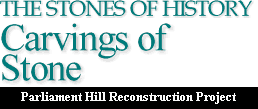

What are those stone figures and carvings staring down from the Peace Tower of the Centre Block on Parliament Hill? Some are replicas of animals, some resemble people, while others portray ancient lurid creatures. Whatever they are, all of them are original carvings which were incorporated into the neo-Gothic architectural style of the buildings on Parliament Hill.
The Parliament buildings are the only government buildings in the world where carving is still taking place on a full-time basis. There are still many uncarved blocks of stone in the interior of the Centre Block that are waiting to be transformed into notable works of art.
Although the carvings are generally referred to as gargoyles, there is a descriptive difference between "gargoyles" and "grotesques"; "friezes" and "bosses".
Gargoyles were created with a two-fold practical purpose. One, to ward off evil and second, to eject excess water from the exterior of buildings. A gargoyle, although sometimes mistaken for a grotesque, is a spout or eavestrough carved in the form of a human or animal figure projecting from a roof gutter to catch rainwater and throw it clear of a building.
A grotesque is a style of decorative art characterized by fanciful human or animal figures that may distort the natural into absurdity, ugliness or caricature. At the turn of the century, grotesques were carved as designs of figures for decoration or adornment on buildings. At the same time, they were made to symbolize a desire to fight the power of evil.
Some grotesques or reliefs were carved onto a frieze, which is a horizontal band of decoration around the upper section of a wall, often ornamented with sculpture.
The term boss is used to describe an ornamental projecting block which can be found at the end of a moulding or an arch.

Carvings of Stone
Frequently Asked Questions
- How many carvings can be found on the Peace Tower?
Approximately 370 - gargoyles, grotesques, carvings, friezes and bosses. - Have any new carvings been added recently to the buildings on Parliament Hill?
Although the exterior carvings are all original, new carvings are added continuously to the interior of the buildings of Parliament Hill. For example, in 1994, a series of 14 carved panels in the Chamber of the House of Commons was completed by the Public Works and Government Services Canada Federal Sculptor. These panels illustrate prehistoric life in Canada, from 400 to 75 million years B.C., with carvings of dinosaurs, reptiles and vegetation. - Is there a data source available which lists and describes the carvings on Parliament Hill?
The Public Works and Government Services Canada Federal Sculptor is currently researching, documenting and photographing every carving on the exterior facades of the buildings on Parliament Hill in order to produce a historic chronicle. - What is the origin of the word "gargoyle"?
The word "gargoyle" comes from the French "gargouille" which means "throat" or "pipe". - When did gargoyles make their debut on structures?
Gargoyles inhabited the great cathedrals of the Middle Ages proliferating between the 11th and 13th centuries. Some of their descendents have ventured away from churches migrating to other important buildings. - Were all gargoyles portrayed as grotesques?
Although most gargoyles were portrayed as frightening figures meant to scare away evil spirits, some were meant to be a "sermon in stone" which could be "read" by an illiterate population. Some gargoyles illustrated biblical stories.